audio Seat Leon 5D 2015 MEDIA SYSTEM TOUCH - COLOUR
[x] Cancel search | Manufacturer: SEAT, Model Year: 2015, Model line: Leon 5D, Model: Seat Leon 5D 2015Pages: 52, PDF Size: 1.43 MB
Page 7 of 52
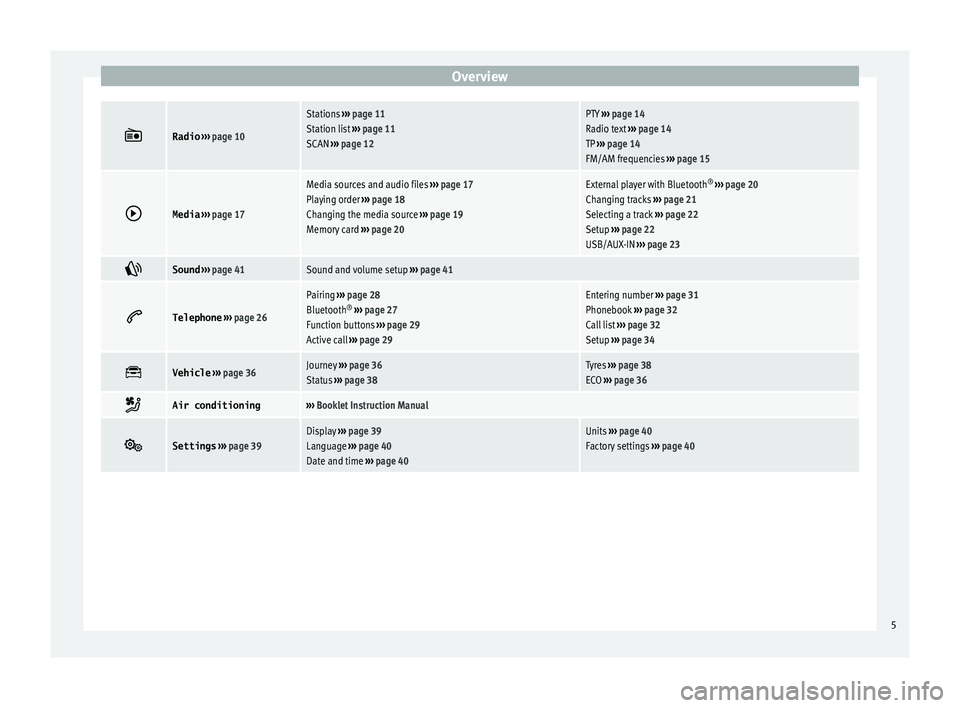
Overview
ÔÄĽRadio
‚Äļ‚Äļ‚Äļ page 10
Stations ‚Äļ‚Äļ‚Äļ page 11
Station list ‚Äļ‚Äļ‚Äļ page 11
SCAN ‚Äļ‚Äļ‚Äļ page 12PTY ‚Äļ‚Äļ‚Äļ page 14
Radio text ‚Äļ‚Äļ‚Äļ page 14
TP ‚Äļ‚Äļ‚Äļ page 14
FM/AM frequencies ‚Äļ‚Äļ‚Äļ page 15 ÔÉ∂
Media
‚Äļ‚Äļ‚Äļ page 17
Media sources and audio files ‚Äļ‚Äļ‚Äļ page 17
Playing order ‚Äļ‚Äļ‚Äļ page 18
Changing the media source ‚Äļ‚Äļ‚Äļ page 19
Memory card ‚Äļ‚Äļ‚Äļ page 20External player with Bluetooth ¬ģ
‚Äļ‚Äļ‚Äļ page 20
Changing tracks ‚Äļ‚Äļ‚Äļ page 21
Selecting a track ‚Äļ‚Äļ‚Äļ page 22
Setup ‚Äļ‚Äļ‚Äļ page 22
USB/AUX-IN ‚Äļ‚Äļ‚Äļ page 23 ÔÄĺ
Sound
‚Äļ‚Äļ‚Äļ page 41Sound and volume setup ‚Äļ‚Äļ‚Äļ page 41 ÔÄĶ
Telephone
‚Äļ‚Äļ‚Äļ page 26
Pairing ‚Äļ‚Äļ‚Äļ page 28
Bluetooth ¬ģ
‚Äļ‚Äļ‚Äļ page 27
Function buttons ‚Äļ‚Äļ‚Äļ page 29
Active call ‚Äļ‚Äļ‚Äļ page 29Entering number ‚Äļ‚Äļ‚Äļ page 31
Phonebook ‚Äļ‚Äļ‚Äļ page 32
Call list ‚Äļ‚Äļ‚Äļ page 32
Setup ‚Äļ‚Äļ‚Äļ page 34 ÔÄł
Vehicle
‚Äļ‚Äļ‚Äļ page 36Journey ‚Äļ‚Äļ‚Äļ page 36
Status ‚Äļ‚Äļ‚Äļ page 38Tyres ‚Äļ‚Äļ‚Äļ page 38
ECO ‚Äļ‚Äļ‚Äļ page 36 ÔĀĀ
Air conditioning‚Äļ‚Äļ‚Äļ
Booklet Instruction Manual ÔÄľ
Settings
‚Äļ‚Äļ‚Äļ page 39Display ‚Äļ‚Äļ‚Äļ page 39
Language ‚Äļ‚Äļ‚Äļ page 40
Date and time ‚Äļ‚Äļ‚Äļ page 40Units ‚Äļ‚Äļ‚Äļ page 40
Factory settings ‚Äļ‚Äļ‚Äļ page 40 5
Page 8 of 52
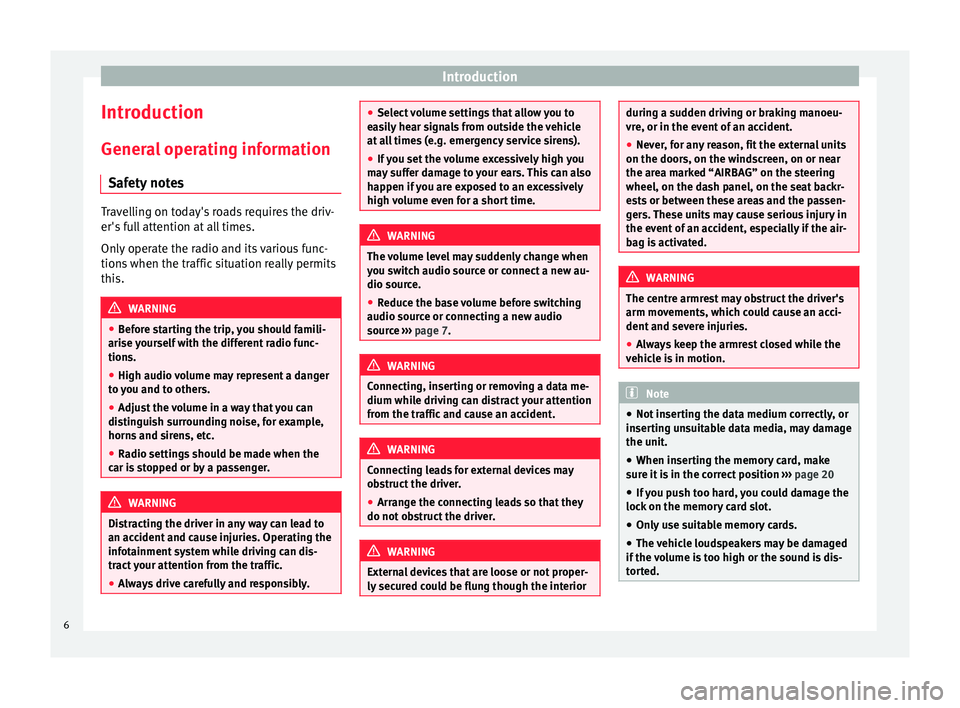
Introduction
Introduction Gener a
l
operating information
Safety notes Travelling on today's roads requires the driv-
er's f
u
ll attention at all times.
Only operate the radio and its various func-
tions when the traffic situation really permits
this. WARNING
‚óŹ Bef or
e starting the trip, you should famili-
arise yourself with the different radio func-
tions.
‚óŹ High audio volume may represent a danger
to y
ou and to others.
‚óŹ Adjust the volume in a way that you can
distin
guish surrounding noise, for example,
horns and sirens, etc.
‚óŹ Radio settings should be made when the
car is
stopped or by a passenger. WARNING
Distracting the driver in any way can lead to
an acc ident
and cause injuries. Operating the
infotainment system while driving can dis-
tract your attention from the traffic.
‚óŹ Always drive carefully and responsibly. ‚óŹ
Select
volume settings that allow you to
easily hear signals from outside the vehicle
at all times (e.g. emergency service sirens).
‚óŹ If you set the volume excessively high you
may
suffer damage to your ears. This can also
happen if you are exposed to an excessively
high volume even for a short time. WARNING
The volume level may suddenly change when
y ou sw it
ch audio source or connect a new au-
dio source.
‚óŹ Reduce the base volume before switching
audio source or c
onnecting a new audio
source ‚Äļ‚Äļ‚Äļ page 7. WARNING
Connecting, inserting or removing a data me-
dium whil e driv
ing can distract your attention
from the traffic and cause an accident. WARNING
Connecting leads for external devices may
ob s
truct the driver.
‚óŹ Arrange the connecting leads so that they
do not ob
struct the driver. WARNING
External devices that are loose or not proper-
ly sec ur
ed could be flung though the interior during a sudden driving or braking manoeu-
vre, or in the ev
ent
of an accident.
‚óŹ Never, for any reason, fit the external units
on the doors, on the wind
screen, on or near
the area marked ‚ÄúAIRBAG‚ÄĚ on the steering
wheel, on the dash panel, on the seat backr-
ests or between these areas and the passen-
gers. These units may cause serious injury in
the event of an accident, especially if the air-
bag is activated. WARNING
The centre armrest may obstruct the driver's
arm mo vement
s, which could cause an acci-
dent and severe injuries.
‚óŹ Always keep the armrest closed while the
vehicl
e is in motion. Note
‚óŹ Not in ser
ting the data medium correctly, or
inserting unsuitable data media, may damage
the unit.
‚óŹ When inserting the memory card, make
sure it
is in the correct position ‚Äļ‚Äļ‚Äļ page 20
‚óŹ If you push too hard, you could damage the
lock on the memor
y card slot.
‚óŹ Only use suitable memory cards.
‚óŹ The vehicle loudspeakers may be damaged
if the v
olume is too high or the sound is dis-
torted. 6
Page 9 of 52
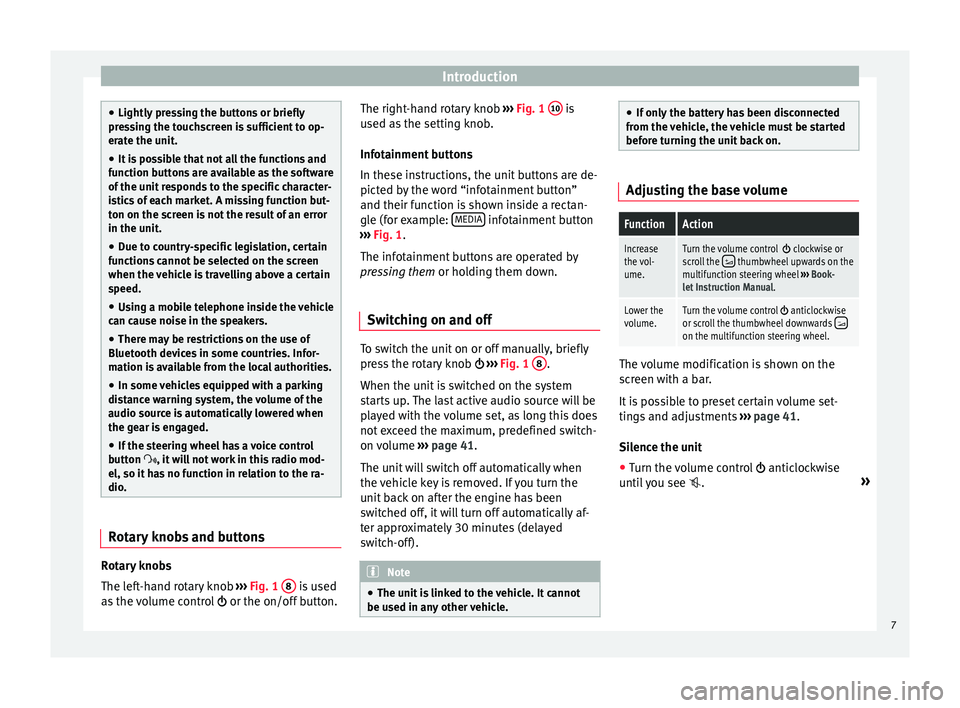
Introduction
‚óŹ
Lightly pr e
ssing the buttons or briefly
pressing the touchscreen is sufficient to op-
erate the unit.
‚óŹ It is possible that not all the functions and
function b
uttons are available as the software
of the unit responds to the specific character-
istics of each market. A missing function but-
ton on the screen is not the result of an error
in the unit.
‚óŹ Due to country-specific legislation, certain
function
s cannot be selected on the screen
when the vehicle is travelling above a certain
speed.
‚óŹ Using a mobile telephone inside the vehicle
can cau
se noise in the speakers.
‚óŹ There may be restrictions on the use of
Bluetooth devic
es in some countries. Infor-
mation is available from the local authorities.
‚óŹ In some vehicles equipped with a parking
dist
ance warning system, the volume of the
audio source is automatically lowered when
the gear is engaged.
‚óŹ If the steering wheel has a voice control
button
ÔĀĶ, it will not work in this radio mod-
el, so it has no function in relation to the ra-
dio. Rotary knobs and buttons
Rotary knobs
The l
ef
t
-hand rotary knob ‚Äļ‚Äļ‚Äļ Fig. 1 8 is used
a s
the
volume control ÔÉľ or the on/off button. The right-hand rotary knob
‚Äļ‚Äļ‚Äļ
Fig. 1 10 is
u sed a
s
the setting knob.
Infotainment buttons
In these instructions, the unit buttons are de-
picted by the word ‚Äúinfotainment button‚ÄĚ
and their function is shown inside a rectan-
gle (for example: MEDIA infotainment button
‚Äļ ‚Äļ
‚Äļ
Fig. 1.
The infotainment buttons are operated by
pressing them or holding them down.
Switching on and off To switch the unit on or off manually, briefly
pr
e
s
s the rotary knob ÔÉľ ‚Äļ‚Äļ‚Äļ Fig. 1 8 .
When the u nit
i
s switched on the system
starts up. The last active audio source will be
played with the volume set, as long this does
not exceed the maximum, predefined switch-
on volume ‚Äļ‚Äļ‚Äļ
page 41.
The unit will switch off automatically when
the vehicle key is removed. If you turn the
unit back on after the engine has been
switched off, it will turn off automatically af-
ter approximately 30 minutes (delayed
switch-off). Note
‚óŹ The unit i
s linked to the vehicle. It cannot
be used in any other vehicle. ‚óŹ
If on ly
the battery has been disconnected
from the vehicle, the vehicle must be started
before turning the unit back on. Adjusting the base volume
FunctionAction
Increase
the vol-
ume.Turn the volume control ÔÉľ clockwise or
scroll the ÔĀě thumbwheel upwards on the
multifunction steering wheel ‚Äļ‚Äļ‚Äļ Book-
let Instruction Manual.
Lower the
volume.Turn the volume control ÔÉľ anticlockwise
or scroll the thumbwheel downwards ÔĀüon the multifunction steering wheel. The volume modification is shown on the
s
c
r
een with a bar.
It is possible to preset certain volume set-
tings and adjustments ‚Äļ‚Äļ‚Äļ
page 41.
Silence the unit
‚óŹ Turn the volume control ÔÉľ anticlock
wise
until you see ÔÄę. ¬Ľ
7
Page 10 of 52

Introduction
‚óŹ OR: Pr e
s
s the MUTE function button
‚Äļ ‚Äļ
‚Äļ
Fig. 4 1)
.
While the unit is muted, the active media
source is paused. ÔÄę is displayed on the
screen. Note
If the basic playback volume of an audio
sourc e h
as been increased substantially, low-
er the volume before changing to another au-
dio source. Operating the function buttons on-
s
c
r
een Fig. 3
View of possible function buttons Fig. 4
View of possible function buttons The unit is equipped with a touchscreen
‚Äļ ‚Äļ
‚Äļ
Fig. 1 2 .
The activ e ar
e
as of the screen that represent
a function are called ‚Äúfunction buttons‚ÄĚ and
are used by pressing them briefly on the dis-
play or holding them down . The function but-
tons are represented in the instructions with
the word ‚Äúfunction buttons‚ÄĚ and the button
symbol - - - .
F u
nction b
uttons start functions or open sub-
menus. The menu currently selected is
shown in the submenus title line ‚Äļ‚Äļ‚Äļ Fig. 3 A .
The f u
nction b
uttons that appear deactivated
(in grey) may not be selected at that time. Summary of the indications and function
button
s
Action and effect
AThe title line shows the menu selected at
that time and, if applicable, other function
buttons ‚Äļ‚Äļ‚Äļ Fig. 3.
BPress to open an additional menu
‚Äļ‚Äļ‚Äļ Fig. 3.
CMove the control around the screen by
pressing lightly, without lifting your finger
‚Äļ‚Äļ‚Äļ Fig. 3.
D
Move the cursor around the screen by
pressing lightly, without resting your fin-
ger. Alternatively: Press the desired desti-
nation on the screen; the cursor will move
to this position ‚Äļ‚Äļ‚Äļ Fig. 4.
BACK ÔāŅBriefly press to return progressively to the
main menu from a submenu, or to undo
the changes made. ÔÉŹ
Press briefly to open a pop-up window
with additional setup options. To close
the pop-up window briefly press outside
of it or select an option.
ÔĀĚ
/ ÔĀě
Activated/deactivated function.
Some functions or instructions are
marked with a checkbox, and are activa-
ted or deactivated by touching them brief-
ly.
1)
According to version
8
Page 15 of 52
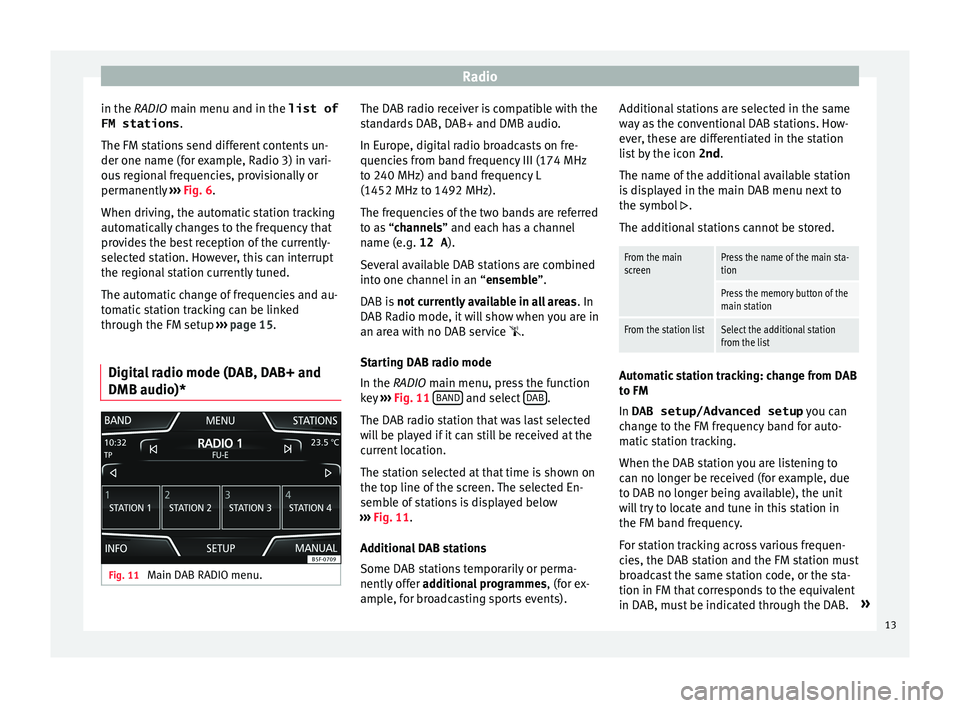
Radio
in the RADIO m ain menu and in the
list of
FM stations .
The FM s
tations send different contents un-
der one name (for example, Radio 3) in vari-
ous regional frequencies, provisionally or
permanently ‚Äļ‚Äļ‚Äļ Fig. 6.
When driving, the automatic station tracking
automatically changes to the frequency that
provides the best reception of the currently-
selected station. However, this can interrupt
the regional station currently tuned.
The automatic change of frequencies and au-
tomatic station tracking can be linked
through the FM setup ‚Äļ‚Äļ‚Äļ page 15.
Digital radio mode (DAB, DAB+ and
DMB audio)* Fig. 11
Main DAB RADIO menu. The DAB radio receiver is compatible with the
s
t
and
ards DAB, DAB+ and DMB audio.
In Europe, digital radio broadcasts on fre-
quencies from band frequency III (174 MHz
to 240 MHz) and band frequency L
(1452 MHz to 1492 MHz).
The frequencies of the two bands are referred
to as ‚Äúchannels‚ÄĚ and each has a channel
name (e.g. 12 A ).
Several available DAB stations are combined
into one channel in an ‚Äúensemble‚ÄĚ.
DAB is not currently available in all areas . In
DAB Radio mode, it will show when you are in
an area with no DAB service Ôā≥.
Starting DAB radio mode
In the RADIO main menu, press the function
key ‚Äļ‚Äļ‚Äļ Fig. 11 BAND and select
D
AB .
The D AB r
a
dio station that was last selected
will be played if it can still be received at the
current location.
The station selected at that time is shown on
the top line of the screen. The selected En-
semble of stations is displayed below
‚Äļ‚Äļ‚Äļ Fig. 11.
Additional DAB stations
Some DAB stations temporarily or perma-
nently offer additional programmes , (for ex-
ample, for broadcasting sports events). Additional stations are selected in the same
way
as the conventional DAB stations. How-
ever, these are differentiated in the station
list by the icon 2nd.
The name of the additional available station
is displayed in the main DAB menu next to
the symbol ÔÉć.
The additional stations cannot be stored.
From the main
screenPress the name of the main sta-
tion
Press the memory button of the
main station
From the station listSelect the additional station
from the list Automatic station tracking: change from DAB
t
o FM
In DAB setup/Advanced setup y
ou c
an
change to the FM frequency band for auto-
matic station tracking.
When the DAB station you are listening to
can no longer be received (for example, due
to DAB no longer being available), the unit
will try to locate and tune in this station in
the FM band frequency.
For station tracking across various frequen-
cies, the DAB station and the FM station must
broadcast the same station code, or the sta-
tion in FM that corresponds to the equivalent
in DAB, must be indicated through the DAB. ¬Ľ
13
Page 17 of 52

Radio
Some stations that do not have their own
tr affic
new
s support the TP function by broad-
casting traffic announcements from other
stations (EON).
Switching the TP function on and off
‚óŹ In the menu Setup (FM, AM and
DAB), pres
s the function button
Traffic Program (TP) to activate ÔĀĚ or de
activ
at
e
ÔĀě this function ‚Äļ‚Äļ‚Äļ page 15.
If the station you are listening to at that time
does not support the TP function,
 will be
displayed halfway up the left of the screen.
Active TP function and station selection
While the traffic news tracking is operative, in
audio mode TP will be displayed half-way up
the screen on the left ‚Äļ‚Äļ‚Äļ Fig. 14. In this case,
the traffic announcements of the current sta-
tion or of the station that broadcasts the cor-
responding traffic information will be played.
In FM mode, the station tuned in must have
the TP function. If, after activating the TP
function, you manually select or use the stor-
ed station buttons to select a station that
does not support the TP function, it will not
check for traffic announcements (display:
 ).
When the traffic announcement station that
is tuned in stops being received, the symbol 
wi
l
l also be displayed, and you must
search for a station manually.
During operation in AM or Media mode, a
traffic announcement station is always set
automatically in the background, provided
there is one that can be tuned in. Depending
on your location, this process can take some
time.
Incoming traffic alert In active Audio mode, an incoming traffic an-
nou
nc
ement
will play automatically.
During the traffic announcement, a pop-up
window is displayed and the radio changes,
depending on the case, to the traffic news
station (EON).
The media mode is paused and the volume is
adjusted to the preset level ‚Äļ‚Äļ‚Äļ page 41.
The volume of the traffic announcement can
be adjusted with the volume control. The ad-
justed volume setting will be applied to sub-
sequent announcements.
‚óŹ Press the function button Cancel to end the
c urr
ent
traffic announcement. The TP function
remains activated.
‚óŹ OR: Press the function button De
activate to
end the c urrent
traffic announcement and
permanently deactivate the TP function. This
can be reactivated in the setup menu. Setup (FM, AM, DAB) FM setup
‚óŹ Select the frequency band FM by pr
essing
the infotainment button RADIO .
‚óŹ Press the function button Setup to open the
menu FM setup .
Function button: function
SCAN: Scan function. When the scan function is active,
all available stations on the current frequency band are
played in sequence for approximately 5 seconds each
‚Äļ‚Äļ‚Äļ page 12. ÔĀĚ
Traffic news station (TP)*: The TP function (traffic news
station tracking) is active ‚Äļ‚Äļ‚Äļ page 14 a)
.
Seek mode: determines the setup of the buttons with ar-
rows ÔÉę and Ôɨ. This setting applies to all frequency
bands (FM, AM and DAB).
Preset list: All stored stations on the selected frequen-
cy band can be selected with the arrow buttons.
Station list: All available stations on the selected fre-
quency band can be selected with the arrow buttons.
Sort by*: to choose the mode in which the stations will
be arranged a)
.
Group: sort by station group.
Alphabet: sort by alphabetical order.
Delete presets: to delete all or some of the stored sta-
tions.
Advanced settings*:¬Ľ 15
Page 19 of 52

Media
Media
M edi
a mode
Intr
oduction Media sources are audio sour
c
es containing
audio files on various different data media
(for example, external MP3 player). These au-
dio files can be played by the infotainment
system from its corresponding drives or au-
dio input sockets (memory card slot, AUX-IN
multi-media socket etc.) Note
‚óŹ The audio coding technology MPEG-4 HE-
AAC and p
atents have a Fraunhofer IIS li-
cence.
‚óŹ This product is protected by copyright and
property
rights of Microsoft Corporation. Us-
ing or distributing similar technology outside
of this product without a licence from Micro-
soft or any of its authorised subsidiaries is
prohibited.
‚óŹ The infotainment system only plays undam-
aged comp
atible audio files; other files are
ignored.
‚óŹ Consult the list of supported devices on the
web
. Media source and audio file require-
ment
s The supported file formats listed are collec-
tively
r
eferred to below as "audio files".
Media sourcesRequirements for play-
ing in the unit ÔĀę
SD and MMC memo-
ry cards in accordance
with FAT12, FAT16,
FAT32, XFAT or VFAT file
systems with a maxi-
mum of 2 Gb (giga-
bytes), in addition to
SDHC and SDXC memo-
ry cards.
‚Äď MP3 files (.mp3) with a
rate of 8 to 320 kbit/s or var-
iable.
‚Äď WMA files (.wma) of up to
9.2 mono/stereo with no
copy protection.
‚Äď Playlists in PLS, M3U, WPL
and ASX formats.
‚Äď Playlists no larger than
1000 elements or 20 kB.
‚Äď Filenames and addresses
no larger than 256 charac-
ters.
‚Äď On memory cards: a maxi-
mum of 1000 folders and a
maximum of 2048 files. ÔÉß
USB data medium
meeting the specifica-
tion 2.0 in accordance
with FAT12, FAT16,
FAT32 or VFAT file sys-
tems with a maximum of
2 Gb (gigabytes). ÔĀĒ
Audio file playback via
Bluetooth ¬ģa)
.‚Äď The external media player
must support the Bluetooth
profile A2DP.
a)Bluetooth ¬ģ
is a registered trademark of Bluetooth SIG, Inc.
Restrictions and instructions
Contamination, exposure to high tempera-
tures and mechanical damage may render a
data medium unusable. Please observe the
manufacturer's instructions.
Variations in the quality of data media pro-
duced by different manufacturers may lead to
anomalies during playback.
Please observe copyright laws.
The unit may be unable to read individual
tracks or the entire data medium due to the
data medium configuration or the devices
and programs used for recording. Informa-
tion can be found on the internet regarding
the best ways to create audio files and data
media (compression rate, ID3 tag etc.).
Depending on the size, its condition due to
use (copy and delete processes), the folder
structure and file type, the read time of the
data media used can vary considerably.
Playlists only determine a certain playing or-
der. There are no files stored in a playlist. The
unit will not play a playlist if the files are not
on the data medium at the locations referred
to by the playlist (relative file paths). Note
‚óŹ Do not u se a
daptors for memory cards.
‚óŹ We will not accept any responsibility for
file
s damaged or lost on the data medium. 17
Page 20 of 52
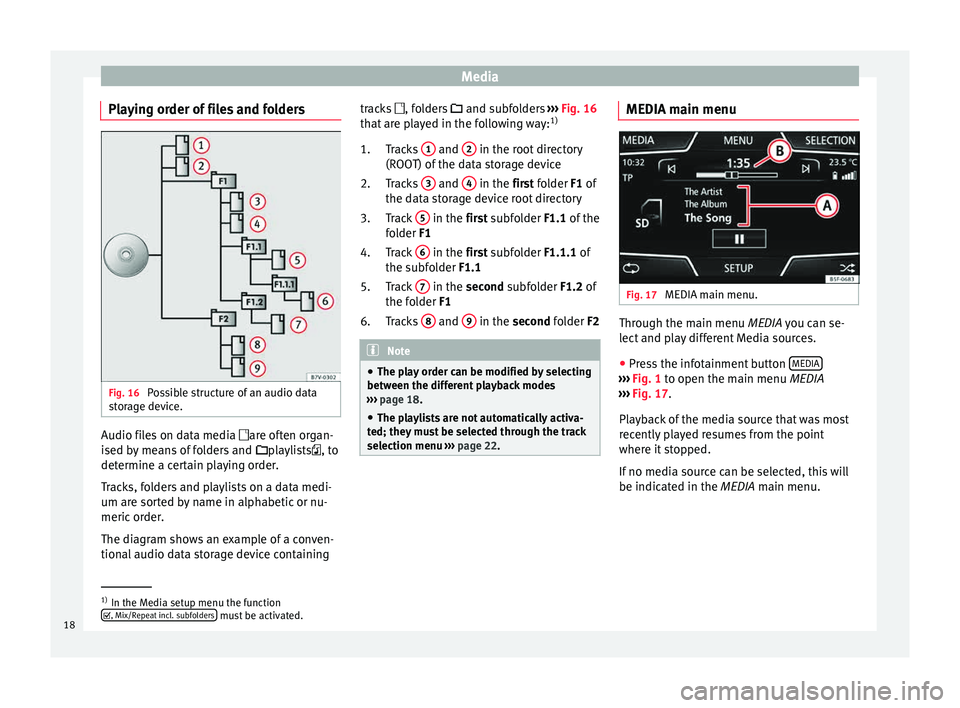
Media
Playing order of files and folders Fig. 16
Possible structure of an audio data
s t
or
age device. Audio files on data media
ÔĀĘare of
t
en organ-
ised by means of folders and ÔÄĪplaylistsÔāī, to
determine a certain playing order.
Tracks, folders and playlists on a data medi-
um are sorted by name in alphabetic or nu-
meric order.
The diagram shows an example of a conven-
tional audio data storage device containing tracks
ÔĀĘ, folders ÔÄĪ and s
ubfolders ‚Äļ‚Äļ‚Äļ Fig. 16
that are played in the following way: 1)
Tracks 1 and
2 in the root directory
(ROO T) of
the d
ata storage device
Tracks 3 and
4 in the fir
st folder F1 of
the d at
a storage device root directory
Track 5 in the fir
st subfolder F1.1 of the
f o
lder F1
Track 6 in the fir
st subfolder F1.1.1 of
the s ubf
older F1.1
Track 7 in the sec
ond subfolder F1.2 of
the f o
lder F1
Tracks 8 and
9 in the sec
ond folder F2 Note
‚óŹ The pl a
y order can be modified by selecting
between the different playback modes
‚Äļ‚Äļ‚Äļ page 18.
‚óŹ The playlists are not automatically activa-
ted; they mu
st be selected through the track
selection menu ‚Äļ‚Äļ‚Äļ page 22. 1.
2.
3.
4.
5.
6.
MEDIA main menu Fig. 17
MEDIA main menu. Through the main menu MEDIA y
ou c
an se-
l
ect and play different Media sources.
‚óŹ Press the infotainment button MEDIA ‚Äļ‚Äļ‚Äļ
Fig. 1 to open the m ain menu
MEDIA
‚Äļ‚Äļ‚Äļ Fig. 17.
Playback of the media source that was most
recently played resumes from the point
where it stopped.
If no media source can be selected, this will
be indicated in the MEDIA main menu. 1)
In the Media setup menu the function
ÔĀĚ, Mix/R epe
at incl. subfolders must be activated.
18
Page 21 of 52

Media
Function buttons of the main menu MediaFunction button: Function
MEDIA
Press to select another media source
‚Äļ‚Äļ‚Äļ page 19.
SD card
: SD memory card ‚Äļ‚Äļ‚Äļ page 20.
Bluetooth audio: Bluetooth audio
‚Äļ‚Äļ‚Äļ page 20.
USB
: USB data medium ‚Äļ‚Äļ‚Äļ page 23.
AUX: external audio source ‚Äļ‚Äļ‚Äļ page 23.
SELECTIONOpens the list of tracks ‚Äļ‚Äļ‚Äļ page 22. ÔÉę
or Changes track in Media mode
‚Äļ‚Äļ‚Äļ page 21. ÔĀģ
Playback will stop. The function buttonÔĀģ changes to ÔÉć
‚Äļ‚Äļ‚Äļ page 21. ÔÉć
Playback will continue. The function but-
ton ÔÉć changes to ÔĀģ
‚Äļ‚Äļ‚Äļ page 21.
SETUPOpens the menu Media setup
‚Äļ‚Äļ‚Äļ page 22. ÔāÖ
Repeat all the tracks.
ÔāÜ
Repeat the current track.
ÔāĄ
Random play. Information and possible icons
Display: Meaning
A‚Äļ‚Äļ‚Äļ
Fig. 17
Display of track information (ID3 tag in
MP3 files).
Audio files: display of the artist name,
album title and song title.
B‚Äļ‚Äļ‚Äļ Fig. 17
Playing time so far.
The time bar allows you to select the de-
sired playing time. ÔÄę
RDS radio data service deactivated. The
RDS can be activated in the menu
Setup
(FM, AM) ‚Äļ‚Äļ‚Äļ page 15.
TPThe TP is active and receiving ‚Äļ‚Äļ‚Äļ page 14. ÔĨ
No traffic announcement station can be
received.
Changing the media source
Fig. 18
Changing media source. ‚óŹ
In the m ain menu
MEDIA
, repeatedly press
the infotainment button MEDIA to activate all
the av ai
l
able media sources, one after anoth-
er.
‚óŹ OR: In the main menu, pre
ss the MEDIA
button ‚Äļ‚Äļ‚Äļ Fig. 18 and select the required me-
dia source.
In the pop-up window, the media sources not
selected are shown as deactivated (in grey).
When a media source that has already been
played is selected again, playback is re-
sumed from the point at which it was stop-
ped.
Media sources that can optionally be selec-
ted
Function button: media source
SD card: SD memory card ‚Äļ‚Äļ‚Äļ page 20.
USB: USB data medium ‚Äļ‚Äļ‚Äļ page 23.
BT audio: playing audio files via Bluetooth ¬ģ
‚Äļ‚Äļ‚Äļ page 20.
AUX: external audio source connected to the AUX-IN
multimedia socket ‚Äļ‚Äļ‚Äļ page 23. 19
Page 22 of 52
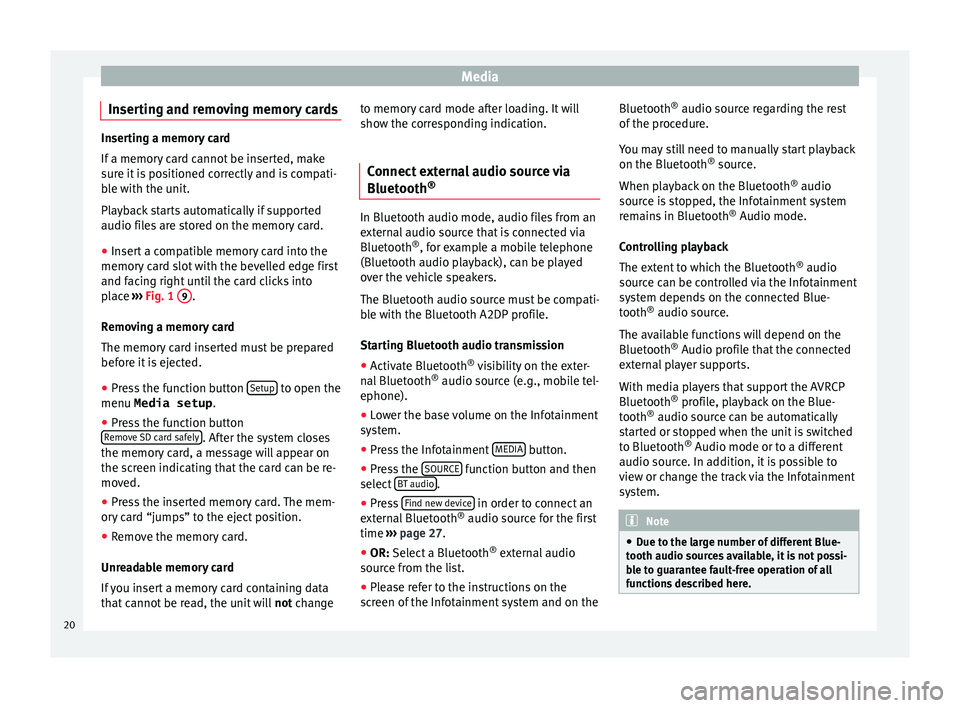
Media
Inserting and removing memory cards Inserting a memory card
If a memor
y
card cannot be inserted, make
sure it is positioned correctly and is compati-
ble with the unit.
Playback starts automatically if supported
audio files are stored on the memory card.
‚óŹ Insert a compatible memory card into the
memory c
ard slot with the bevelled edge first
and facing right until the card clicks into
place ‚Äļ‚Äļ‚Äļ Fig. 1 9 .
R emo
v
ing a memory card
The memory card inserted must be prepared
before it is ejected.
‚óŹ Press the function button Setup to open the
menu Media setup .
‚óŹ Press the function button
R emo
v
e SD card safely . After the system closes
the memor y
c
ard, a message will appear on
the screen indicating that the card can be re-
moved.
‚óŹ Press the inserted memory card. The mem-
ory c
ard ‚Äújumps‚ÄĚ to the eject position.
‚óŹ Remove the memory card.
Unrea
dable memory card
If you insert a memory card containing data
that cannot be read, the unit will not changeto memory card mode after loading. It will
show the corr
esponding indication.
Connect external audio source via
Bluetooth ¬ģ In Bluetooth audio mode, audio files from an
ext
ern
al audio source that is connected via
Bluetooth ¬ģ
, for example a mobile telephone
(Bluetooth audio playback), can be played
over the vehicle speakers.
The Bluetooth audio source must be compati-
ble with the Bluetooth A2DP profile.
Starting Bluetooth audio transmission
‚óŹ Activate Bluetooth ¬ģ
vi s
ibility on the exter-
nal Bluetooth ¬ģ
audio source (e.g., mobile tel-
ephone).
‚óŹ Lower the base volume on the Infotainment
syst
em.
‚óŹ Press the Infotainment MEDIA button.
‚óŹ Press the SOURC
E function button and then
sel ect
B
T audio .
‚óŹ Press Find new dev
ic
e in order to connect an
e xt
ern
al Bluetooth ¬ģ
audio source for the first
time ‚Äļ‚Äļ‚Äļ
page 27.
‚óŹ OR: Select a Bluetooth ¬ģ
ext
ernal audio
source from the list.
‚óŹ Please refer to the instructions on the
scr
een of the Infotainment system and on the Bluetooth
¬ģ
audio source r
egarding the rest
of the procedure.
You may still need to manually start playback
on the Bluetooth ¬ģ
source.
When playback on the Bluetooth ¬ģ
audio
source is stopped, the Infotainment system
remains in Bluetooth ¬ģ
Audio mode.
Controlling playback
The extent to which the Bluetooth ¬ģ
audio
source can be controlled via the Infotainment
system depends on the connected Blue-
tooth ¬ģ
audio source.
The available functions will depend on the
Bluetooth ¬ģ
Audio profile that the connected
external player supports.
With media players that support the AVRCP
Bluetooth ¬ģ
profile, playback on the Blue-
tooth ¬ģ
audio source can be automatically
started or stopped when the unit is switched
to Bluetooth ¬ģ
Audio mode or to a different
audio source. In addition, it is possible to
view or change the track via the Infotainment
system. Note
‚óŹ Due t o the l
arge number of different Blue-
tooth audio sources available, it is not possi-
ble to guarantee fault-free operation of all
functions described here. 20